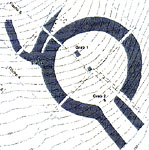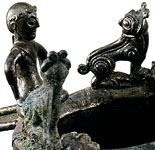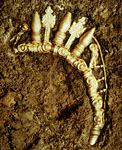|
Statue in situ
Found in a wide trench to the west of Tomb 1
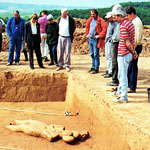 Local sandstone
Local sandstone
life-size -- 1.86 m pres. H
after Herrmann 1996,
334 fig 2
|
Excavating the statue, 1996
Armor and shield are clearly visible; rear view not yet
published
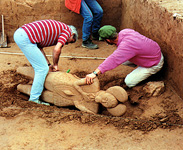
after Herrmann 1996,
334 fig 3
|
|
Detail of statue

Bearded head of statue with "Blattkrone" -- wreath
of leaves very common on La Tène A heads, usually
interpreted as divine. From the photos, the headgear looks
to me to consist of two parts: the teardrop-shaped
appendages to the sides, and a helmet of LTA type on the
head. Note the torc with 3 balusters, bracelet, armlets and
ring. The staring eyes and downturned moustache result in
an extremely grim expression.
after Herrmann 1996,
333 fig 1
|
The proportions and pose of the figure are reminiscent of
those of the late-Hallstatt period "warrior" from
Hirschlanden. The Glauberg figure is far from naked,
however; he is clad in armor, provided with a shield and
plenty of jewelry. His elaborate finery places him closer
to the "warrior" from Capestrano than the naked Hirschlanden
figure.
The similarity of the parure to that discovered in Tomb 1
in the same tumulus has led to speculation that the statue
might represent a portrait of the Tomb 1 occupant or of
another Keltenfürst buried in the tumulus. We
have no reason to believe that the Celts practiced
portraiture, however; indeed, their art appears to be
consistently non-naturalistic. In addition, the Glauberg
statue's head is flanked by two protrusions of a type
usually associated with non-mortal figures, e.g. the
four-sided pillar from Pfalzfeld, or the Janus-headed
sculpture from Holzgerlingen. I am not convinced that the
Glauberg statue represents a mortal, much less as a
portrait.
|

